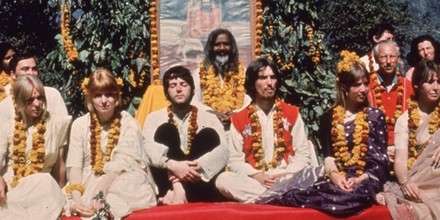For decades, the world has watched the efforts to bring peace in the Middle East with hopeful eyes and heavy hearts. Endless negotiations, summits, and ceasefires have aimed to bring peace—but the cycle of conflict persists. Is there an alternative to negotiation and warfare? One alternative solution is the Maharishi Effect. This doesn’t rely on politics or power—but on creating a wave of peace in society through a quantum field.
More specifically, the idea known as the Maharishi Effect is a research-backed theory that suggests when large groups of people practice this technology together, they can generate a wave of peace that spreads outward, lowering collective stress and even reducing violence in society.
Sound far-fetched? And it’s not just theory—decades of research back it up.
Multiple studies have shown that group meditation can have measurable, positive effects on community well-being, especially in areas riddled with tension and unrest. In fact, during periods where thousands have gathered to meditate together, researchers recorded notable drops in crime, violence, and even terrorism.
In a region like the Middle East, where emotions run deep and solutions often seem out of reach, this approach offers something radically different: a way to change the atmosphere from within—by reducing the stress, fear, and aggression that often drive conflict.
Of course, meditation isn’t a replacement for diplomacy or policy—but it could be a powerful complement. A peaceful mind creates peaceful actions, and when enough people tap into that calm together, the ripple effect might be stronger than we think.
Perhaps the real revolution won’t come through politics, but through silence—through thousands of people sitting quietly, eyes closed, generating peace from the inside out.
Foundations of the Maharishi Effect influencing collective consciousness
Maharishi Mahesh Yogi the founder of Transcendental Meditation introduced the concept that individual peace could extend to societal tranquility.
He suggested that when a critical mass of individuals achieves a higher state of consciousness through meditation, the resultant effect can spread, enhancing the collective consciousness of a larger population.
This theory proposes that the positive effects of group meditation can reduce societal stress, conflict, and violence.
Tapping into Collective Peace: Transcendental Meditation and the TM-Sidhi Program
At the heart of the Maharishi Effect lies a simple yet powerful daily practice: Transcendental Meditation (TM). Practiced twice a day for 20 minutes, this technique doesn’t require belief, religion, or lifestyle changes—it’s effortless and accessible to anyone. But when taken to the next level with the TM-Sidhi Program, something even more extraordinary happens.
The TM-Sidhi Program, an advanced extension of TM, is designed to deepen one’s connection with what physicists refer to as the unified field—a field that underlies all of nature’s laws. Practicing this technique in a group isn’t just beneficial for the individual—it may have profound effects on society as a whole.
And through focused group meditation, we can tap into that field which connects everything and radiate peace outward.
What the Science Says About Group Meditation
Decades of research point to a fascinating discovery: when a critical mass of individuals practice the TM-Sidhi Program together—specifically, the square root of 1% of a population—remarkable changes start to unfold. Studies have shown significant reductions in crime rates, conflict, and even fatalities in areas where large groups of practitioners gather regularly.
A New Vision for Global Harmony
The combination of Transcendental Meditation, the TM-Sidhi Program, and rigorous scientific validation forms the foundation of the Maharishi Effect—an unconventional but evidence-based approach to creating real, lasting peace.
It challenges the idea that peace can only come from top-down policies or external negotiations. Instead, it offers something revolutionary: a way to reduce societal stress at its source—within human consciousness itself.
Global Impact of the Maharishi Effect: A Quiet Force for Change
What if peace didn’t have to start in a boardroom or on a battlefield—but instead, within the human mind?
As the Maharishi Effect gains traction worldwide, one thing is becoming clear: collective meditation can create powerful ripples across entire societies. Strategic implementations of Transcendental Meditation—especially in large groups—have already led to noticeable, measurable shifts in public behavior and community well-being.
How Meditation is Changing the World, One City at a Time
When enough people practice TM—specifically the advanced TM-Sidhi Program—a fascinating transformation unfolds. Crime drops. Tension eases. Hope returns. This isn’t just anecdotal; the data backs it up.
✨ Notable Results from Around the Globe:
- Violent crime rates fall: In multiple urban studies, cities saw significant decreases in assaults, homicides, and other violent crimes during and after group meditation assemblies.
- Uplift in community well-being: Broader quality-of-life indicators—like mental health, job satisfaction, and social harmony—improved in areas influenced by regular collective meditation.
- Positive behavioral shifts: Researchers noticed a shift toward more cooperative, peaceful public behavior in places impacted by TM groups.
From Conflict Zones to Peace Projects
This isn’t just about safer neighborhoods—it’s about global transformation.
Over the past few decades, large-scale TM and TM-Sidhi assemblies have been mobilized in response to international tensions and crises. These peace initiatives aimed not just to observe but to intervene—quietly, powerfully—through synchronized meditation efforts.
The result? Multiple studies show a statistically significant link between these group meditations and a drop in international conflicts, terrorism, and civil unrest.
A New Model for Global Harmony
The Maharishi Effect offers something radically different in our pursuit of peace: an inside-out approach, where change begins in the collective consciousness and spreads across borders. It invites us to imagine a world where thousands of people coming together in silence can have more impact than weapons or politics ever could.
Could a peaceful planet begin with peaceful people? The evidence says yes.
Notable Case Studies: Applying the Maharishi Effect for Peace in the Middle East
 The Lebanon War Intervention
The Lebanon War Intervention
In 1983, during the peak of the Lebanon War, a two-month intervention was conducted in Jerusalem involving individuals practicing Transcendental Meditation and TM-Sidhi programs. This study, detailed in findings on An Antidote to Violence, observed that, on days when the size of the group was at or above the predicted threshold level, war deaths in Lebanon decreased by 76%. The group’s meditation practice was suggested to positively influence the conflict.
Improvements were also found in composite indices of quality of life (including data on crime, motor vehicle accidents, fires, national mood) in Israel when the group was large enough to predict effects at the city or national levels.
Reducing Violence and Conflict in the Middle East
Following the Lebanon War Intervention, Transcendental Meditation has been employed with the goal of reducing violence and conflict in the broader Middle East. Studies, such as the one listed on An Antidote to Violence, have shown correlational results where days with large meditation group gatherings saw a decrease in the intensity of fires in warfare and an increase in cooperation among conflicting parties. These effects suggest the potential impact of collective consciousness on regional peace and stability.
 Replication of the war-intensity study
Replication of the war-intensity study
The finding of reduced war in Lebanon was subsequently replicated for all seven assemblies that comprised TM-Sidhi groups of sufficient size to predict the Maharishi Effect for the region during the peak of the conflict between 1983 and 1985. This included groups located in or close to Lebanon and larger assemblies further afield. Statistical analysis, which controlled for temperature, holidays, and weekends, demonstrated that the results were independent of alternative explanations. Multiple indicators of reduced conflict replicated the findings when combining intervention periods, including 66% increase in cooperation between antagonists; 71% reduction in war-related fatalities; 68% decrease in war-related injuries; and 48% reduction in levels of conflict.(23).
Ted Gurr, emeritus Professor of Government and Politics at the University of Maryland and distinguished scholar in the domain of conflict analysis, stated:
“In the studies I have examined on the impact of [Maharishi Effect] on conflict. I can find no methodological flaws, and the findings have been consistent across a large number of replications in many different geographical and conflictual situations. As unlikely as the premise may sound, I think we have to take these studies seriously.”
 Reduced fatalities and crime in US
Reduced fatalities and crime in US
Compared to trends in the 50-month pre-intervention period (when group size was well below the critical threshold), the 48-month intervention period showed cumulative reductions in US national mortality rates from: homicide (21.2% decrease); motor vehicle accident fatalities (13.5% decrease); other accidental fatalities (20.5% decrease); drug-related deaths (20.5% decrease); and infant mortality (12.5% decrease).(4-7)
Reductions were also found for rates of violent crime (18.4% decrease) and murder (28.4% decrease), measured in a sample of 206 urban areas (total population 60 million in 2010). Interestingly, although these urban areas initially had higher murder rates than the country as a whole, they experienced a greater percentage decline during the experimental period.(7)
The authors examined other possible explanations for these results, but none were found to account for the decreases in these usually unconnected variables.
 Prospective study in US reduction in crime
Prospective study in US reduction in crime
4,000 participants in the TM-Sidhi program gathered in Washington DC for a six-week demonstration project in 1993. Predictions were lodged in advance with a 27-member independent review panel and advertised in the Washington Post.The results provide evidence of a dosage effect: when numbers participating increased, the effects were greater. Findings showed a 23.3% reduction in total violent crime during the project period, as well as increased approval ratings for President Clinton. In addition, accidents, emergency psychiatric calls, hospital trauma cases and complaints against police all decreased, while the quality of life index improved.
Current Activities in the Middle East:
Following the tragic attacks near the Gaza border, Israeli teachers stepped in to teach TM to survivors, providing a powerful tool for emotional healing and inner peace.
A Lifeline for Survivors of Trauma
Dr. Mooli Lahad, founder and president of the Community Stress Prevention Center in northern Israel, is one of the country’s leading trauma specialists. After studying decades of TM research, he now sees it as a core method for recovery from both acute and chronic PTSD.
“TM could be the solution for many people facing overwhelming hardship,” Lahad explains. “It offers a direct path to restoring emotional balance and well-being.”
And the experiences of survivors speak volumes:
“These have been the hardest days of my life. But TM brings me a deep sense of calm. The nightmares I had after October 7 have faded. TM helps me manage my anger and make peace with the pain.”
— Adva Trachenberg
“I arrived at the hotel as a refugee, constantly stressed, snapping at others over nothing. Then I learned TM—and something shifted. I felt grounded, more accepting. I finally feel like life is moving in the right direction again.”
— Tai Rozen
“After attending several funerals, I felt like I would never smile again. But TM gave me back my hope. I feel energized, optimistic, even joyful. Peace is possible.”
— Sagit Levy
The Bigger Picture: Bringing Peace to Society
What began as personal healing is now evolving into something much larger—a national and even global strategy to create peace from within.
Integration Across Key Institutions
Government
TM is being introduced into government offices to reduce stress and improve decision-making. Early pilot programs show promise in fostering calm, clear thinking and more harmonious policy environments.
Education
Schools and universities are embracing TM to help students and teachers reduce anxiety, improve focus, and thrive academically. Research consistently shows that TM boosts cognitive function and emotional resilience.
Healthcare
TM is being adopted as a wellness practice with practitioners reporting fewer stress-related illnesses and better overall mental health. These outcomes have the potential to ease pressure on public health systems.
The Numbers Don’t Lie: Measurable Social Impact
- Crime rates have dropped significantly in cities where a threshold number of people practice TM together.
Looking Forward: Peace as a Scalable Solution
Scaling for Global Change
The Maharishi Vedic Research Institute is working to expand these programs through:
- New Training Centers in countries worldwide, providing access to TM and advanced techniques.
- Community Engagement to inspire collective participation and reach the numbers required to create measurable societal change.
- Cultural Adaptation to ensure practices are embraced within local traditions and belief systems.
Sustaining Peace Through Science and Practice
Lasting transformation requires ongoing commitment and rigorous research. That’s why long-term studies continue to evaluate TM’s impact on health, education, and social stability.
- Long-term research is confirming consistent declines in violence and stress-related outcomes.
- Public Policy Integration is bringing meditation into education and healthcare systems for sustainable impact.
- Community Sustainability ensures these benefits continue even without external support.
A Vision for a Peaceful Future
The Maharishi Effect shows that peace doesn’t have to be an abstract ideal—it can be a real, repeatable outcome of collective consciousness.
Dr. Raymond Russ, Professor of Psychology at the University of Maine and former editor of The Journal of Mind and Behavior, put it bluntly:
“The numbers are there. The statistical work is sound. This evidence suggests we now have a new technology for generating peace in the world.”
The Opportunity Before Us
Around the world, Transcendental Meditation is proving that healing starts within. As more people experience the calm and coherence it brings, entire communities are beginning to shift.
Could the key to peace lie not in louder voices, but in quiet minds?
List of Scientific Research Studies on the Maharishi Effect
David Orme-Johnson, PhD
Lee Fergusson, PhD
This compilation includes 118 papers on the Maharishi Effect, examining the impact of Transcendental Meditation and/or TM-Sidhi programs on conflict and social indicators. It comprises 55 papers from peer-reviewed journals or conference proceedings, 38 from research anthologies (mainly “Scientific Research on Maharishi’s Transcendental Meditation and TM-Sidhi Program: Collected Papers”), 4 on physiological variables, and 21 theoretical or review articles.
Papers Published in Peer Reviewed Journals or Professional Conference Proceedings
2023. Dillbeck, M. C., & Cavanaugh, K. L. (2023). Empirical Evaluation of the Possible Contribution of Group Practice of the Transcendental Meditation and TM-Sidhi Program to Reduction in Drug-Related Mortality. Medicina, 59, 1-32.
2022. Orme-Johnson, D. W., Cavanaugh, K. L., Dillbeck, M. C., & Goodman, R. S. (2022). Field-effects of consciousness: A seventeen-year study of the effects of group practice of the Transcendental Meditation and TM-Sidhi programs on reducing national stress in the United States. World Journal of Social Science, 9(2), 1-38.
2022. Cavanaugh, K. L., Dillbeck, M. C., & Orme-Johnson, D. W. (2022). Evaluating a field theory of consciousness and social change: Group: Practice of transcendental meditation and homicide trends. Studies in Asian Social Science, 8(1), 1-32.
2019. Gelderloos, P., Cavanaugh K.L., Frid, M. & Xue, X. (2019). Warming U.S.-Soviet relations during the Cold War as measured by U.S. presidential statements: Impact of the group practice of the Transcendental Meditation-Sidhi program. Journal of Maharishi Vedic Research Institute, 9, 93-134.
2019. Fergusson, L., & Cavanaugh, K. L. (2019). Socio-political violence in Cambodia between 1990 and 2008: An explanatory mixed methods study of social coherence. Studies in Asian Social Science, 6(2), 1-45.
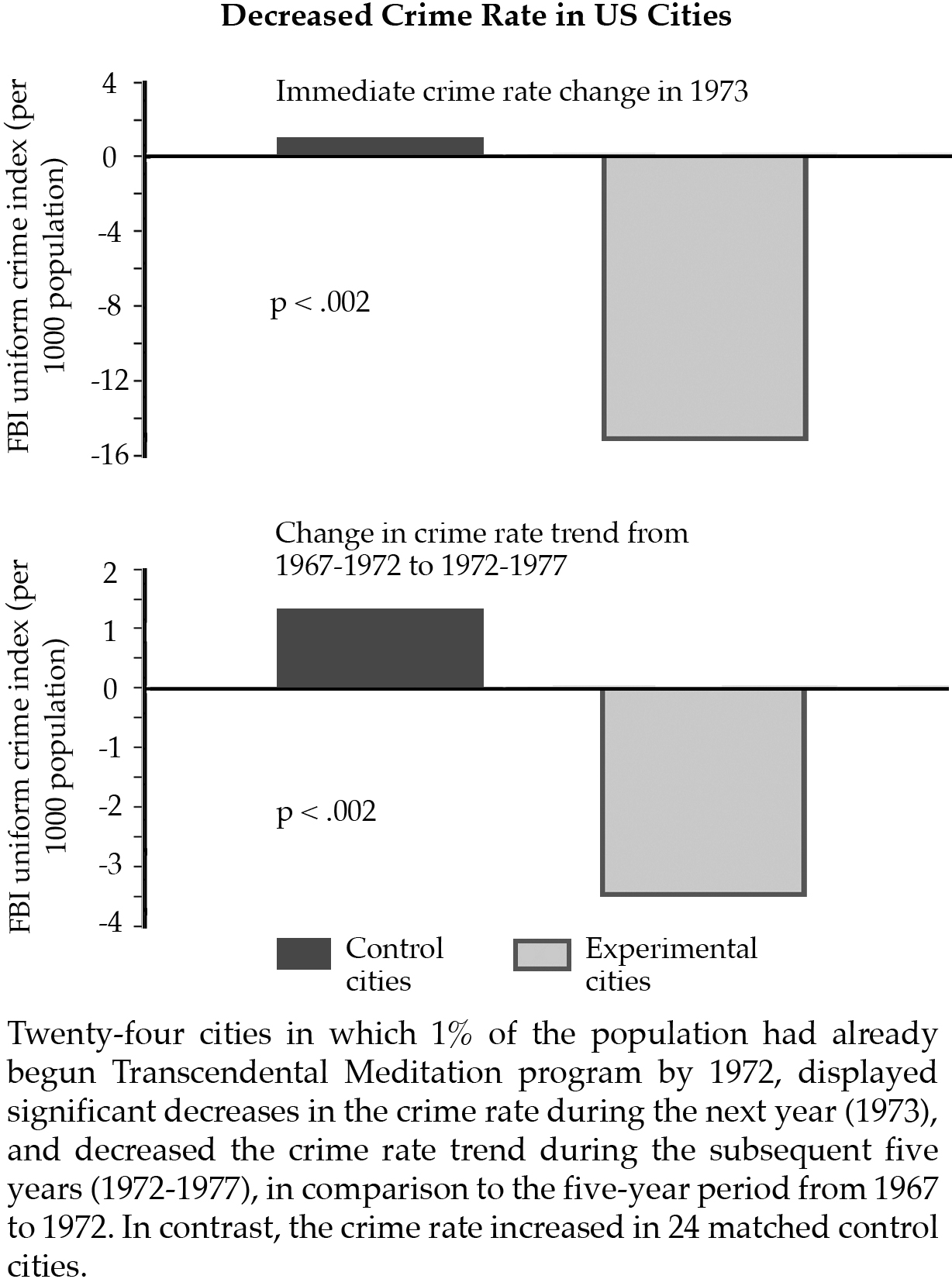
2018. Kenneth L. Cavanaugh, K. L., Gelderloos, P., & Dillbeck, M.C. (2018). Group practice of the Transcendental Meditation-Sidhi program and improved U.S.-Soviet relations. Journal of Maharishi Vedic Research Institute, 8, 125–164.
2017. Cavanaugh, K. L., & Dillbeck, M. C. (2017). Researching US urban murder rates and group practice of the Transcendental Meditation and TM-Sidhi program: Evaluation of a prospective quasi-experiment. Journal of Maharishi Vedic Research Institute, 5, 11-40.
2017. Dillbeck MC, Cavanaugh KL. (2017). Group Practice of the Transcendental Meditation® and TM-Sidhi® Program and Reductions in Infant Mortality and Drug-Related Death: A Quasi-Experimental Analysis. SAGE Open, January-March:1-15.
2017. Cavanaugh KL, Dillbeck MC. (2017). Field Effects of Consciousness and Reduction in U.S. Urban Murder Rates: Evaluation of a Prospective Quasi-Experiment. Journal of Health and Environmental Research, 3(3-1):32-43.
2017. Cavanaugh KL, Dillbeck MC. (2017). The contribution of proposed field effects of consciousness to the prevention of U.S. accidental fatalities: Theory and empirical tests. Journal of Consciousness Studies, 24(1-2):53–86.
2017. Hatchard, G., & Cavanaugh, K. L. (2017). The Effect of Coherent Collective Consciousness on National Quality of Life and Economic Performance Indicators—An Analysis of the IMD Index of National Competitive Advantage. Journal of Health and Environmental Research, 3(3-1):16-31.
2016. Fergusson L. (2016). The impact of Maharishi Vedic University on Cambodian economic and social indicators from 1980 to 2015. Journal of Maharishi Vedic Research Institute, 2:77-135.
2016. Fergusson, L. (2016). Vedic science-based education, poverty removal and social well-being: A case history of Cambodia from 1980 to 2015. Journal of Indian Education (Journal of the National Council of Educational Research and Training), 41(4), 16-45.
2016. Orme-Johnson DW. (2016). Factor analysis of social indicators in the Middle East: Effects of cultural, military, political, and climatic events and group practice of the Transcendental Meditation and TM-Sidhi programs. Journal of Maharishi Vedic Research Institute, 1(1).
2016. Dillbeck MC, Cavanaugh KL. (2016). Societal violence and collective consciousness: Reduction of U.S. homicide and urban violent crime rates. SAGE Open, April-June:1-16.
2005. Davies, J. L., and C. N. Alexander (2005). Alleviating political violence through reducing collective tension: Impact Assessment analysis of the Lebanon war. Journal of Social Behavior and Personality, 2005, 17: 285-338.
2003. Orme-Johnson, D. W., M. C. Dillbeck, C. N. Alexander, H. M. Chandler, and R. W. Cranson (2003). Effects of large assemblies of participants in the Transcendental Meditation and TM-Sidhi program on reducing international conflict and terrorism. Journal of Offender Rehabilitation, 36 (1/2/3/4):283-302.
1999. J. S. Hagelin, M.V. Rainforth, D. W. Orme-Johnson, K. L. Cavanaugh, C. N. Alexander, S. F. Shatkin, et al. (1999). Effects of group practice of the Transcendental Meditation program on preventing violent crime in Washington, DC: Results of the National Demonstration Project, June–July 1993. Social Indicators Research, 47(2):153-201.
1997. Goodman R. S., D. W. Orme-Johnson, M. S. Rainforth, and D. H. Goodman (1997). Transforming political institutions through individual and collective consciousness: The Maharishi Effect and government. Annual Meeting of the American Political Science Association; Washington, D.C.
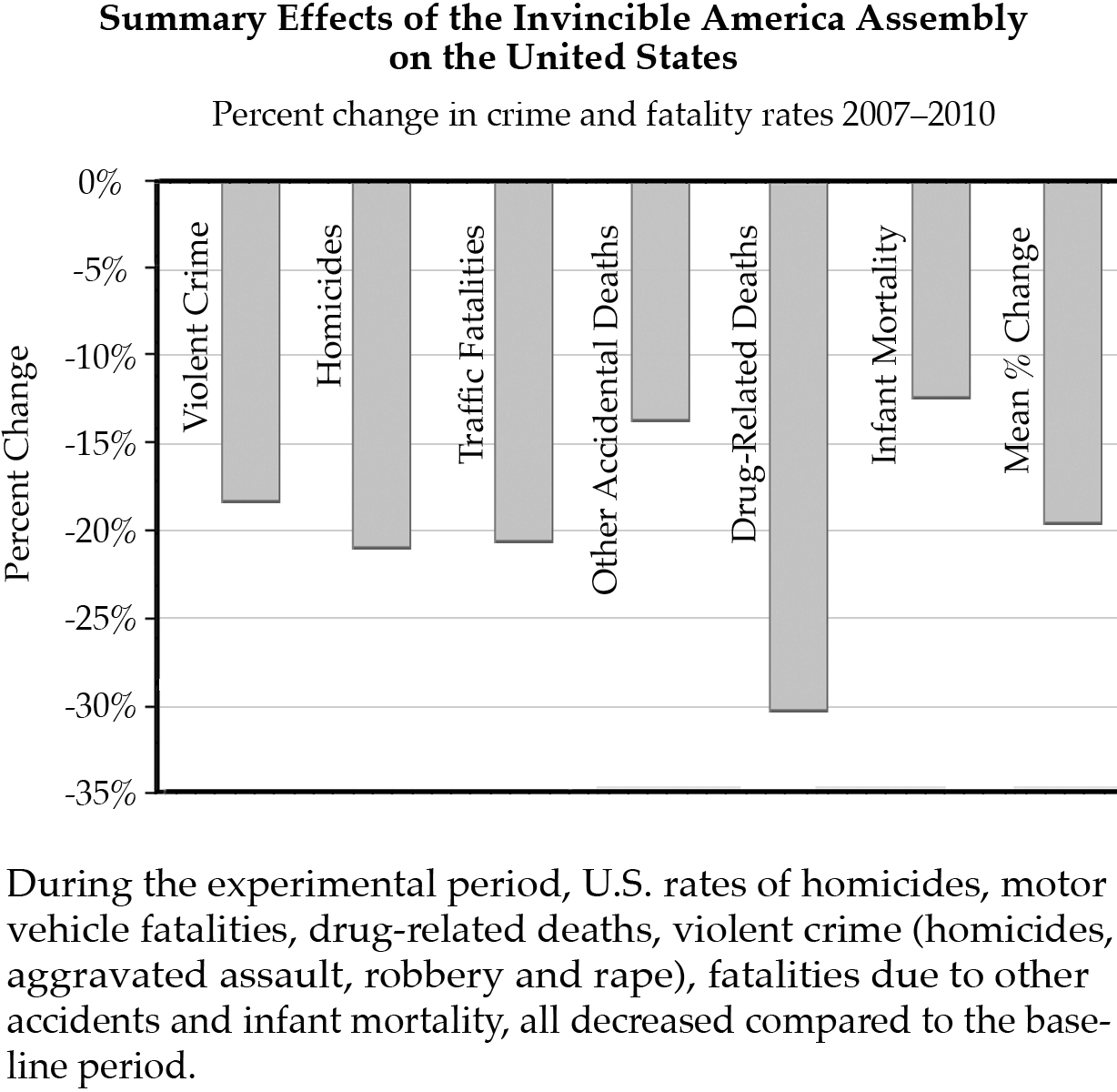
1996. Hatchard, G. D., A. J. Deans, K. L. Cavanaugh, and D. W. Orme-Johnson (1996). The Maharishi Effect: A model for social improvement. Time series analysis of a phase transition to reduced crime in Merseyside metropolitan area. Psychology, Crime & Law; 2(3):165-174.
1996. Dillbeck, M. C., and M. V. Rainforth (1996). Impact assessment analysis of behavioral quality of life indices: Effects of group practice of the Transcendental Meditation and TM-Sidhi program. Proceedings of the American Statistical Association, Social Statistics Section,38–43.
1995. Assimakis P., and M. C. Dillbeck (1995). Time series analysis of improved quality of life in Canada: Social change, collective consciousness, and the TM-Sidhi program. Psychological Reports, 76:1171-1193.
1992. Cavanaugh, K. L. (1992). Maharishi’s Vedic Science and Technology: Promoting economic development and world peace. Modern Science and Vedic Science; 5(1-2):172-181.
1990. Orme-Johnson, D. W., C. N. Alexander, and J. L. Davies (1990). The effects of the Maharishi Technology of the Unified Field: Reply to a methodological critique. Journal of Conflict Resolution, 34:756–768.
1990. Gelderloos, P., K. L. Cavanaugh, and J. L. Davies (1990). The dynamics of U.S.-Soviet relations, 1979–1986: A simultaneous transfer function analysis of U.S.-Soviet relations: A test of the Maharishi Effect. Proceedings of the American Statistical Association, Social Statistics Section, 297–302.
1990. Dillbeck, M. C. (1990).Test of a field theory of consciousness and social change: Time series analysis of participation in the TM-Sidhi program and reduction of violent death in the U.S. Social Indicators Research, 22:399–418.
1990. Reeks, D. (1990). Improved Quality of Life in Iowa through the Maharishi Effect. Dissertation Abstracts International, 51(12):6155B.
1989. Cavanaugh K. L., K. D. King, and C. Ertuna (1989). A multiple-input transfer function model of Okun’s misery index: An empirical test of the Maharishi Effect. Proceedings of the American Statistical Association, Business and Economics Statistics Section:565-570.
1989. Cavanaugh, K. L., K. D. King, and B. D. Titus (1989). Consciousness and the quality of economic life: empirical research on the macroeconomic effects of the collective practice of Maharishi’s Transcendental Meditation and TM-Sidhi program. Proceedings of the Midwest Management Society (Chicago, IL: Midwest Management Society), 183-190.
1988. Orme-Johnson, D. W., C. N. Alexander, J. L. Davies, H. M. Chandler, and W. E. Larimore (1988). International peace project in the Middle East: The effect of the Maharishi Technology of the Unified Field. Journal of Conflict Resolution, 32(4):776–812.
1988. Cavanaugh, K. L. and K. D. King. (1988). Simultaneous transfer function analysis of Okun’s misery index: improvements in the economic quality of life through Maharishi’s Vedic Science and technology of consciousness. Proceedings of the American Statistical Association, Business and Economics Statistics Section.
1988. Gelderloos, P., M. J. Frid, P. H. Goddard, X. Xue, and S. A. Löliger (1988). Creating world peace through the collective practice of the Maharishi Technology of the Unified Field: Improved U.S.-Soviet relations. Social Science Perspectives Journal, 2(4):80–94.
1988. Dillbeck, M. C., C. B. Banus, C. Polanzi, and G. S. Landrith III. (1988) Test of a field model of consciousness and social change: The Transcendental Meditation and TM-Sidhi program and decreased urban crime. The Journal of Mind and Behavior, 9(4):457–486.
1988. Orme-Johnson, D. W., and P. Gelderloos (1988).The long-term effects of the Maharishi Technology of the Unified Field on the quality of life in the United States (1960 to 1983). Social Science Perspectives Journal, 2(4):127-146.
1987. Dillbeck, M. C., K. L. Cavanaugh, T. Glenn, D. W. Orme-Johnson, and V. Mittlefehldt (1987). Consciousness as a field: The Transcendental Meditation and TM-Sidhi program and changes in social indicators. The Journal of Mind and Behavior, 8(1):67–104.
1987. Cavanaugh, K. L. (1987). Time series analysis of U.S. and Canadian inflation and unemployment: A test of a field-theoretic hypothesis. Proceedings of the American Statistical Association, Business and Economics Statistics Section, 799-904.
1981. Dillbeck, M. C., G. S. Landrith III, and D. W. Orme-Johnson (1981).The Transcendental Meditation program and crime rate change in a sample of forty-eight cities. Journal of Crime and Justice, 4:25–4
Papers Published in Research Anthologies
1989. Alexander, C. N., T. M. Nader, K. L. Cavanaugh, J. L. Davies, M. C. Dillbeck, R. J. Kfoury, et al. (1989). The effect of the Maharishi Technology of the Unified Field on the war in Lebanon: A time series analysis of the influence of international and national coherence creating assemblies. Scientific Research on Maharishi’s Transcendental Meditation and TM-Sidhi Program: Collected Papers 2687-2714.
1989. Davies, J. L., and C. N. Alexander. (1989) The Maharishi Technology of the Unified Field and improved quality of life in the United States: A study of the First World Peace Assembly, Amherst, Massachusetts, 1979. Scientific Research on Maharishi’s Transcendental Meditation and TM-Sidhi Program: Collected Papers, 4, 2549-2563.
1989. Nader, T. M., C. N. Alexander, and J. L. Davies. (1989). The Maharishi Technology of the Unified Field and reduction of armed conflict: A comparative, longitudinal study of Lebanese villages. Scientific Research on Maharishi’s Transcendental Meditation and TM-Sidhi Program: Collected Papers, 4, 2623-2634.
1989. Orme-Johnson, D. W., K. L. Cavanaugh, C. N. Alexander, P. Gelderloos, M. C. Dillbeck, A. G. Lanford, et al. (1989).The influence of the Maharishi Technology of the Unified Field on world events and global social indicators: The effects of the Taste of Utopia Assembly. Scientific Research on Maharishi’s Transcendental Meditation and TM-Sidhi Program: Collected Papers, 4, 2730-2762.
1989. Orme-Johnson, D. W., M. C. Dillbeck, J. G. Bousquet, and C. N. Alexander. (1989).An experimental analysis of the application of the Maharishi Technology of the Unified Field in major world trouble spots: Increased harmony in international affairs. Scientific Research on Maharishi’s Transcendental Meditation and TM-Sidhi Program: Collected Papers, 4, 2532-2548.
1989. Burgmans, W. H. P. M., A. T. Van Der Burgt, F. P. T. Langenkamp, and J. H. Verstagen. (1989).Sociological effects of the group dynamics of consciousness: Decrease of crime and traffic accidents in Holland. Scientific Research on Maharishi’s Transcendental Meditation and TM-Sidhi Program: Collected Papers, 4, 2566-2582.
1989. Dillbeck, M. C. (1989).The Transcendental Meditation program and a compound probability model as predictors of crime rate change. Scientific Research on Maharishi’s Transcendental Meditation and TM-Sidhi Program: Collected Papers, 4, 2496-2514.
1989. Hatchard, G. Influence of the Transcendental Meditation program on crime rate in suburban Cleveland. (1989). Scientific Research on Maharishi’s Transcendental Meditation and TM-Sidhi Program: Collected Papers, 4,1199-1204.
1989. Lanford, A. G. (1989). Reduction in homicide in Washington, D. C. through the Maharishi Technology of the Unified Field, 1980-83: A time series analysis. Scientific Research on Maharishi’s Transcendental Meditation and TM-Sidhi Program: Collected Papers, 4, 2600-2608.
1989. Beresford, M. S., and G. Clements. (1989).The group dynamics of consciousness and the U.K. stock market. Scientific Research on Maharishi’s Transcendental Meditation and TM-Sidhi Program: Collected Papers, 4, 2616-2622.
1989. Cavanaugh, K. L., D. W. Orme-Johnson, and P. Gelderloos. (1989). The effect of the Taste of Utopia Assembly on the World index of international stock prices. Scientific Research on Maharishi’s Transcendental Meditation and TM-Sidhi Program: Collected Papers, 4, 2715-2729
1989. Dillbeck, M. C., W. E. Larimore, and R. K. Wallace. (1989). A time series analysis of the effect of the Maharishi Technology of the Unified Field: Reduction of traffic fatalities in the United States. Scientific Research on Maharishi’s Transcendental Meditation and TM-Sidhi Program: Collected Papers, 4, 2589-2599.
1989. Landrith III, G. S., and M. C. Dillbeck (1989). The growth of coherence in society through the Maharishi Effect: Reduced rates of suicides and auto accidents. Scientific Research on Maharishi’s Transcendental Meditation and TM-Sidhi Program: Collected Papers, 4, 2479-2486.
1989. Lanford, A. G. (1989).The effect of the Maharishi Technology of the Unified Field on stock prices of Washington, D.C. area based corporations, 1980-83: A time series analysis. Scientific Research on Maharishi’s Transcendental Meditation and TM-Sidhi Program: Collected Papers, 4, 2609-2615.
1984. Dillbeck, M. C., Larimore, W. E., & Wallace, R. K. (1984). A time series analysis of the effect of the Maharishi Technology of the Unified Field: Reduction of traffic fatalities in the United States. Scientific research on the Transcendental Meditation and TM-Sidhi programme: Collected papers, 4, 2589-2599.
1983. Dillbeck, M. C.; Foss, A. P. O.; and Zimmermann, W. J. (1983). Maharishi’s Global Ideal Society Campaign: Improved quality of life in Rhode Island through the Transcendental Meditation and TM-Sidhi program. Scientific research on the Transcendental Meditation and TM-Sidhi programme: Collected Papers, 4, 2521-2531.
1977. Borland, C. L., and G. S. Landrith III. (1977). Improved quality of life through the Transcendental Meditation program: Decreased crime rate. Scientific Research on the Transcendental Meditation Program : Collected Papers 1, 651-658.
Papers on Physiological Effects
2005. Walton, K. G., K. L. Cavanaugh, and N. D. Pugh (2005). Effect of group practice of the Transcendental Meditation program on biochemical indicators of stress in non-meditators: A prospective time series study. Journal of Social Behavior and Personality 2005;17(1):339-376.
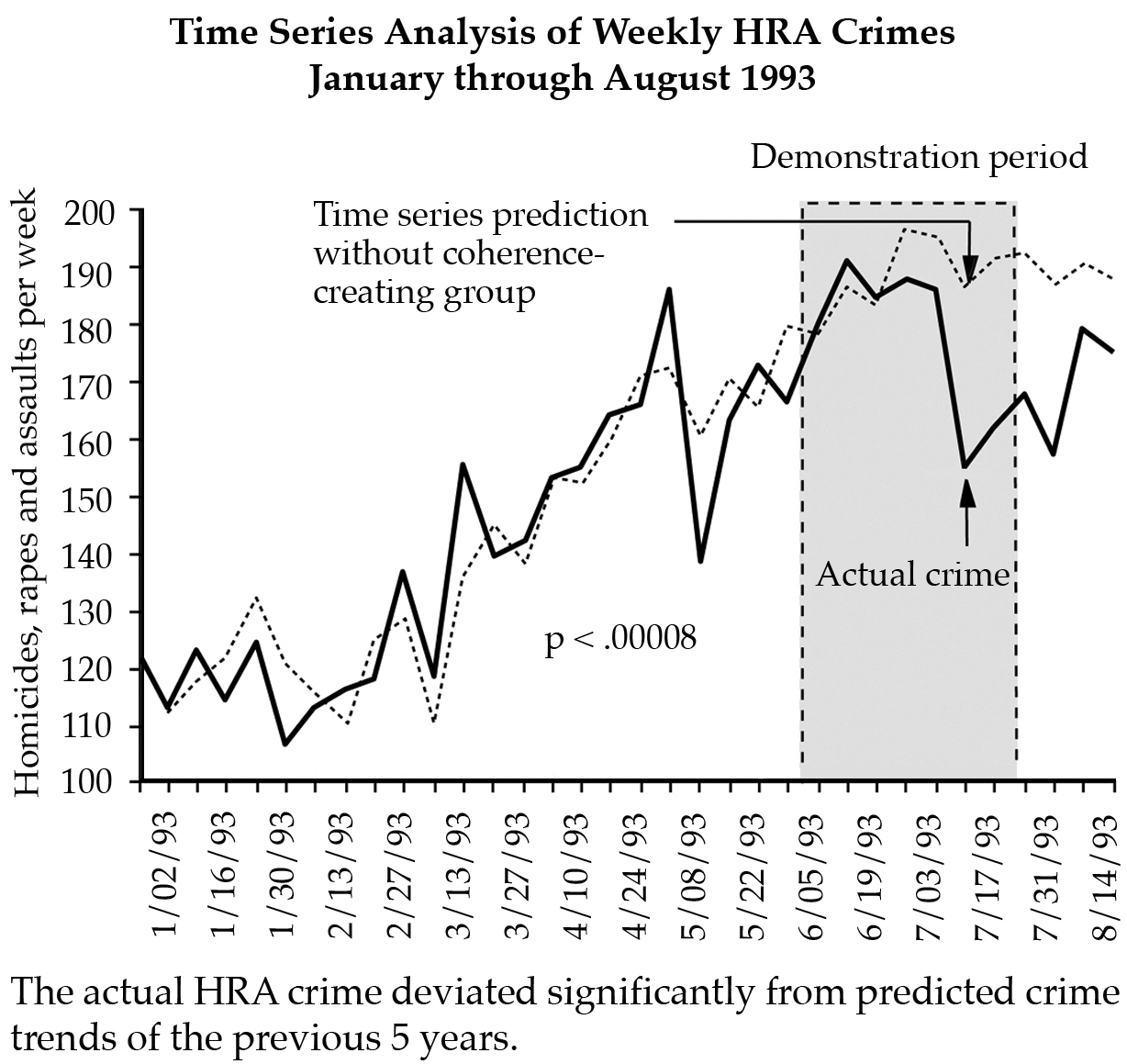
1989. Travis, F. T., and D. W. Orme-Johnson (1989). Field model of consciousness: EEG coherence changes as indicators of field effects. International Journal of Neuroscience 1989; 49:203-211.
1988. Pugh, N. D., K. G. Walton, and K. L. Cavanaugh (1988). Can time series analysis of serotonin turnover test the theory that consciousness is a field? Society of Neuroscience Abstracts 1988; 14:372.
1982. Orme-Johnson, D. W., M. C. Dillbeck, R. K. Wallace, G. S. Landrith. (1982). Intersubject EEG coherence: Is consciousness a field? International Journal of Neuroscience 1982; 16:203-209.
Reviews, Theoretical Papers, and Critiques
2018. Orme-Johnson, D. W., & Fergusson, L. (2018). Global impact of the Maharishi Effect from 1974 to 2017: Theory and research. Journal of Maharishi Vedic Research Institute, 8, 13–79.
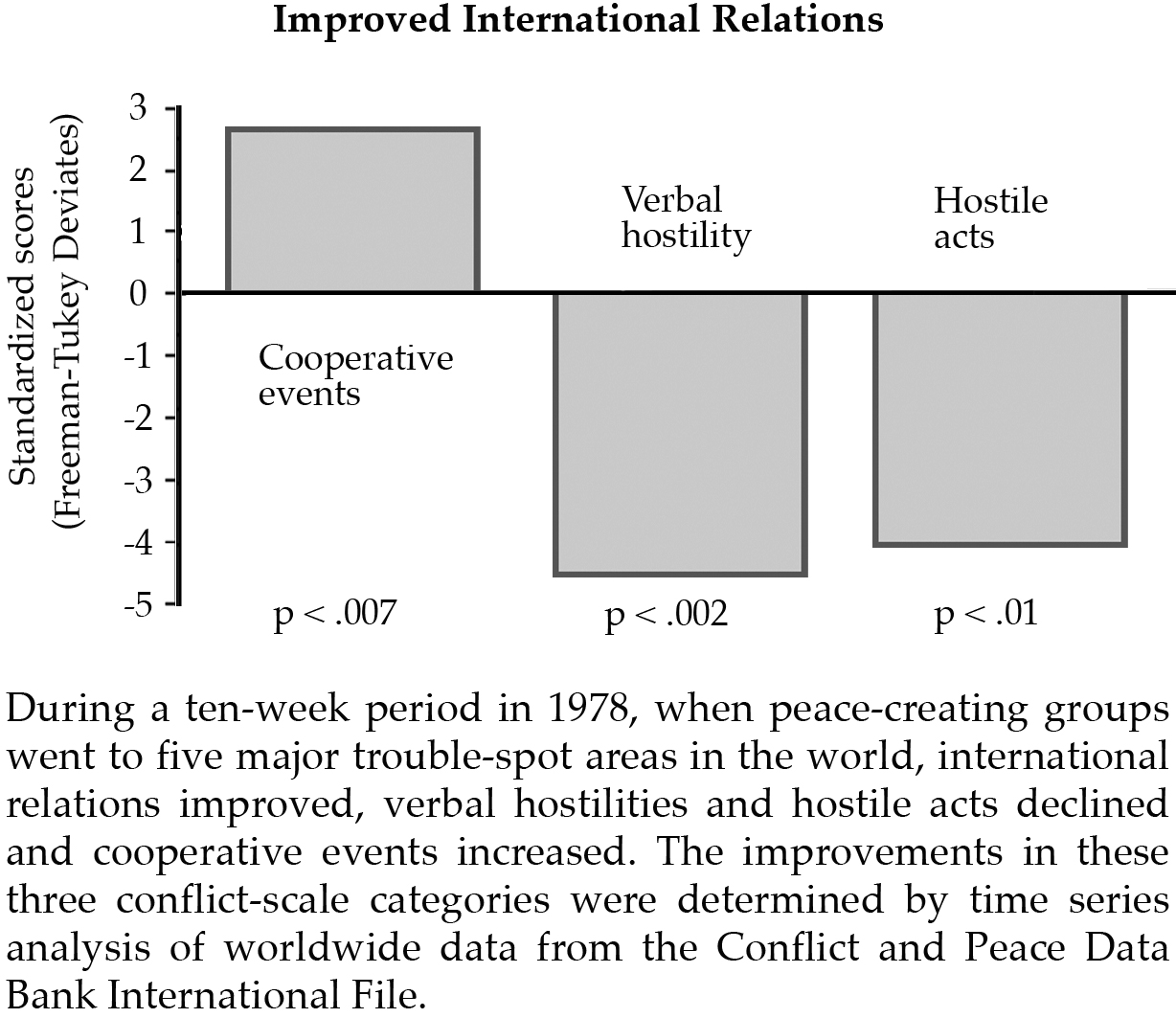
2009. Leffler, D. (2009). A new role for the military: Preventing enemies from arising—reviving an ancient approach to peace. Journal of Management and Social Sciences, 5, 153–162.
2005. Orme-Johnson, D. W. (2005). Section introduction: Collective Consciousness and Peace Studies. Journal of Social Behavior and Personality 2005; 36(1/2/3/4):277-283.
2005. Orme-Johnson, D. W. (2005). Preventing crime though the Maharishi Effect. Journal of Offender Rehabilitation, 2005; 36(1/2/3/4): 257-281.
2005. Brown, C. L. (2005). Overcoming barriers to use of promising research among elite Middle East policy groups. Social Behavior and Personality, 489-544.
2001. Goodman, R. S., D. H. Goodman, and R. Wolfson (2001). A consciousness-based approach to human security. Perspectives on Human Security. Ed. M. V. Naidu. Brandon, Manitoba, Canada: Canadian Peace Research and Education Association, 2001:189-210.
1999. Leffler, D. R., K. Kleinschnitz, & K. G. Walton (1999). An alternative to military violence and fear-based deterrence: Twenty years of research on the Maharishi Effect. Security and Political Risk Analysis (SAPRA) India, 1999. Available at: http://www.subcontinent.com/sapra/military/m_1999_05_01.html
1997. Orme-Johnson, D. W. (1997). Transcendental Meditation as an epidemiological approach to drug and alcohol abuse: Theory, research, and financial impact evaluation. Alcoholism Treatment Quarterly 1994; 11:119-165.
1997. Leffler, D. R. (1997) A Vedic approach to military defense: Reducing collective stress through the field effects of consciousness. Doctoral Dissertation, The Union Institute, Cincinnati, Ohio, 1997. Dissertation Abstracts International 1997; 58(08):3298A. Available at: http://www.davidleffler.com/doctoraldissertation.html

1997. Kleinschnitz, K. G. (1997). An Investigation into Field Effects of Consciousness from the Perspective of Maharishi’s Vedic Science and Physics, 1997, Maharishi University of Management, Dissertation Abstracts International UMI 9713470.
1992. Orme-Johnson, D. W. (1992). Theory and research on conflict resolution through the Maharishi Effect. Modern Science and Vedic Science 1992; 5(1-2):76-98.
1992. Orme-Johnson, D. W. (1992). Introduction to the proceedings of the conference on approaches to creating stable world peace. Modern Science and Vedic Science 1992; 5(1-2):1-30.
1992. Morris, B. (1992). Maharishi’s Vedic Science and Technology: The only way to create world peace. Modern Science and Vedic Science 1992; 5(1-2):199-297.
1992. Hagelin, J. S. (1992). Achieving world peace through a new science and technology. Modern Science and Vedic Science 1992; 5(1-2):48-75.
1992. Alexander, C. N. (1992). Peaceful body, peaceful mind, peaceful world. Modern Science and Vedic Science 1992; 5(1-2):150-163.
1990. Schrodt, P. (1990). Methodological critique of ‘International peace project in the Middle East.’ Journal of Conflict Resolution 1990; 34:756-768.
1990. Edwards, D. V. (1990). On consciousness-centered social conflict theory: The case of the Maharishi technology of the unified field. American Psychological Association; 1990; Boston.
1988. Russett, B. (1988). Editor’s comment. Journal of Conflict Resolution 1988; 32(4):773-775.
1988. Duval R. (1988). TM or not TM? Journal of Conflict Resolution 1988; 32(4):813-817.
1987. Orme-Johnson, D. W., and M. C. Dillbeck.(1987). Maharishi’s program to create world peace: Theory and research. Modern Science and Vedic Science 1987; 1:206-259.
1982. Orme-Johnson, D. W., and M. C. Dillbeck (1982). Statement of David Orme-Johnson. Proposals to establish a U.S. Academy of Peace: Proceedings of the hearing before the Subcommittees on International Security and Scientific Affairs and on International Operations of the Committee on Foreign Affairs, and the Subcommittee on Postsecondary Education of the Committee on Education and Labor, House of Representatives, Ninety-Seventh Congress, Second Session, on bills H.R. 5088 and H.R. 6182, 21 July 1982; Washington, D.C.: U.S. Government Printing Office, 1982:241-250.
24 Journals where Maharishi Effect studies have been published
Annual Meeting of the American Political Science Association
Criminal Rehabilitation and Crime Prevention
Dissertation Abstracts International
Journal of Conflict Resolution 2
Journal of Consciousness Studies
Journal of Crime and Justice
Journal of Health and Environmental Research
Journal of Indian Education (Journal of the National Council of Educational Research and Training
Journal of Maharishi Vedic Research Institute 5
Journal of Offender Rehabilitation
Journal of Social Behavior and Personality
Medicina
Modern Science and Vedic Science
Proceedings of the American Statistical Association, Business and Economics Statistics Section 2
Proceedings of the American Statistical Association, Social Statistics Section 2
Proceedings of the Midwest Management Society
Psychological Reports
Psychology, Crime & Law
SAGE Open2
Social Indicators Research
Social Indicators Research
Social Science Perspectives Journal 2
The Journal of Mind and Behavior 2
World Journal of Social Science
Most of these papers are reprinted in the Scientific Research on Maharishi’s Transcendental Meditation and TM-Sidhi Programme: Collected Papers (Vols. 1-5), which contains 3,732 pages of original research. The Collected Papers are available from Maharishi University of Management Press and can be ordered on the link below.
http://www.miu.edu/mumpress/p_b01-5.html






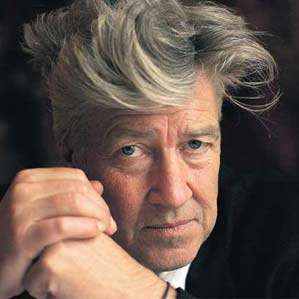


 The Lebanon War Intervention
The Lebanon War Intervention Replication of the war-intensity study
Replication of the war-intensity study Reduced fatalities and crime in US
Reduced fatalities and crime in US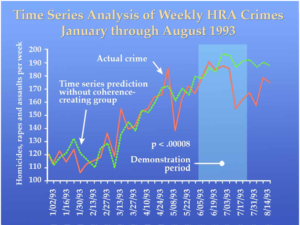 Prospective study in US reduction in crime
Prospective study in US reduction in crime





